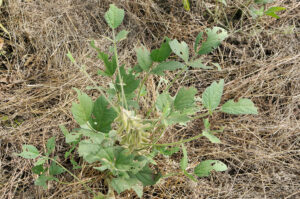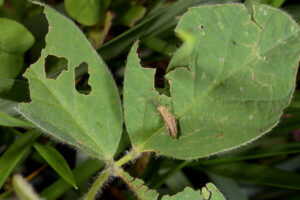Reports of grasshoppers within fields have been received. The pictures and videos included with the emails showed numerous grasshopper nymphs severely defoliating soybean that were planted into a standing cereal rye cover crop. The soybean plants were delayed in growth, as they were shaded by the dying rye. Grasshoppers, as the name suggests, love feeding on a range of grasses but are certainly not limited to this group of plants.
Eggs, laid in the soil last fall, normally hatch from late May through July. After the nymphs hatch, they normally feed for 2 to 3 weeks near the area where the eggs were laid. When their food source becomes scarce or when their early feeding sites are mowed or otherwise destroyed (i.e. burndown with herbicide), the nymphs move to other feeding sites, including nearby crops.
As we often point out, a small insect is easier to manage (i.e. kill) than a larger one. The best time to manage threatening grasshopper populations is when they are still in the nymphal stage (wingless). Besides being smaller, they are easier to control at this time since they are less mobile. However, you should not apply a control whenever you see nymphal grasshoppers – you can find grasshopper nymphs in most any field if you look hard enough, and as a result we advocate for the use of an economically damaging population to justify treatment.
To determine the need for grasshopper control, check crop and non-crop areas to pinpoint infestations. In at least 5 random locations within each infested area, estimate the number of grasshoppers within approximately one square yard. A sweep net may be helpful for this, but certainly not necessary. Grasshoppers are active by day and quite visible. Determine the infestation level for each sample area, and for each crop and non-crop area as a whole.
Treatment of field margins is probably justified if counts exceed 15 or more nymphs or 8 adults (winged) per square yard. In soybean fields, control may be needed if defoliation levels exceed 40% prior to bloom or 25% from blooming to pod fill. In corn, it may be advisable to treat if an average of 3 or more grasshopper nymphs per square yard are counted. In most cases, spot treatment may be sufficient to control the grasshoppers.
Recommended control materials can be found HERE.




